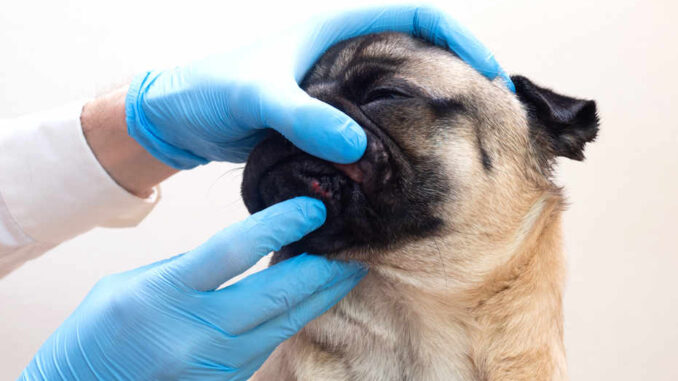
This article was updated on January 14th, 2024

What Does Acne Look Like? [With Pictures]
In simplest terms, dog acne is inflammation in the outermost layers of the skin, called the epidermis, that results in inflamed red or pink bumps, or white bumps around the lips, chin, and muzzle. These bumps or pimples arise from clogged pores and contain a mix of oils, bacteria, and dead skin cells.
The Pug in the picture below has quite severe acne with red bumps, and significant bacterial overgrowth:
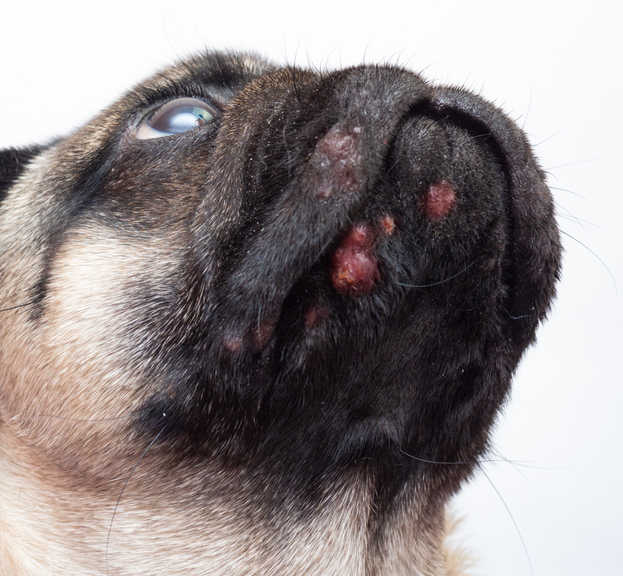
In the picture below, a pug has white/gray pimple-like bumps. Some dogs will develop blackheads, which can become inflamed and occasionally develop into pustules in more severe cases.
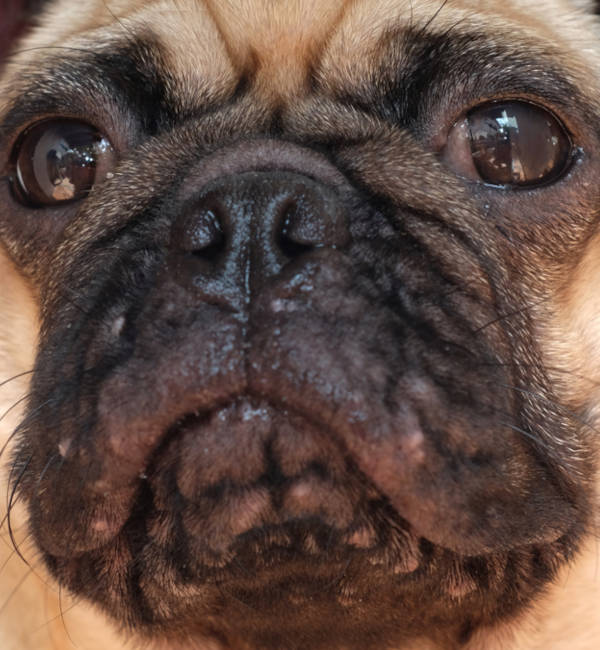
A special gland called a sebaceous gland sits inside these pores along with the hair follicle. When normal oil production is disrupted or trauma to the skin, a clog can form.
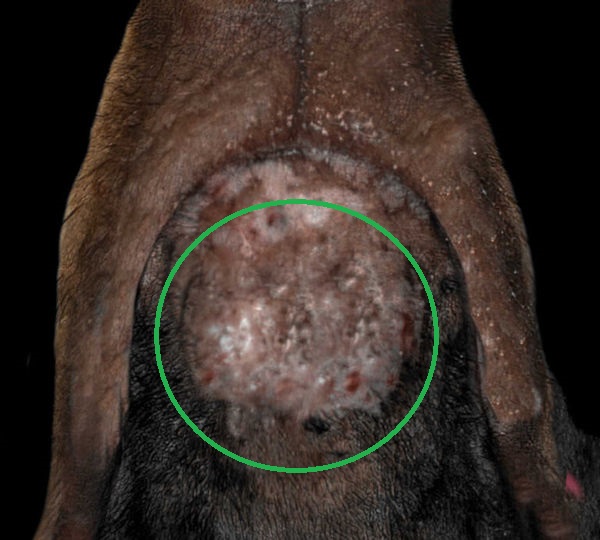
Your vet may refer to the condition as folliculitis or furunculosis. Folliculitis, or inflammation in the follicle, occurs in the most superficial layers of the skin, meaning it isn’t very deep. Furunculosis is a deeper, more painful infection that causes abscesses and pimples.
How can you tell that it’s dog acne?
Dog acne often appears as:
- small red bumps around the lips, muzzle, and chin.
- irritated skin or redness,
- hair loss,
- crusting, and
- swelling around the chin and muzzle, as shown in this picture or on the picture below.
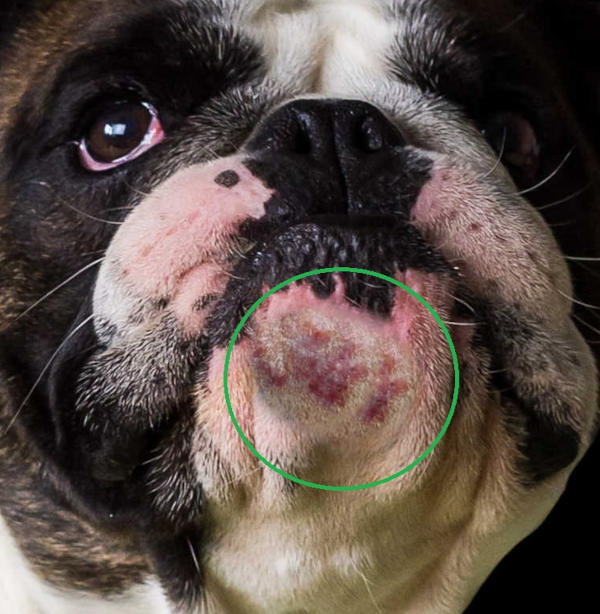
Are dogs bothered by acne?
In mild cases, your dog may not notice the bumps or seem particularly bothered. In more severe, deeper infections, they may be uncomfortable, itchy, and tender. You may also see crusting and discharge from the bumps. The picture above is a mild case.
Acne also impacts other pets
Pictured below is a cat with acne:
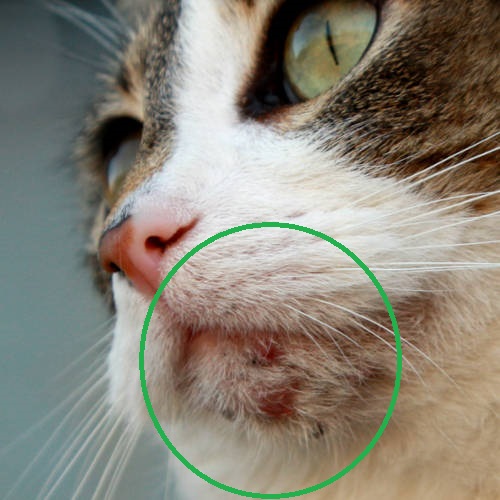
3 tips from our vet to help your dog at home
1. Do not pick or squeeze at the swellings: this can cause further pain and irritation, and prolong healing time. Trying to pop them can also lead to infections and scarring, just like in humans.
2. Keep the area clean and dry: if your dog has not been seen by your vet yet, it is best to just clean the affected area with mild antibacterial soap and cool water rather than put any topical medications on the skin.
You may also use cleansers like PetMD Topical Wipes if given the go-ahead by your vet. These contain chlorohexidine that will help dry and disinfect the skin, but it can be irritating for certain dogs:
- Non Stinging Cleaning Wipes with Topical Solution for the Topical Management of Skin and Coat.
Never use your own skincare products on your dog unless directed by your veterinarian. Some human products have higher concentrations of active ingredients that may be too harsh for your dog’s sensitive skin.
3. Change out toys and bowls: Some dogs’ acne is worsened by plastics, so changing to stainless bowls and natural instead of plastic toys may help. You may also try disinfecting toys with a diluted vinegar solution or mild dish soap.
Never use your own skincare products on your dog unless directed by your veterinarian. Some human products have higher concentrations of active ingredients that may be too harsh for your dog’s sensitive skin.
When to call your veterinarian?
Dog acne is rarely an emergency, but it should be addressed if your dog seems uncomfortable or the skin is getting worse. A mild case of acne may resolve on its own with time and gentle cleaning; more severe inflammation, facial swelling, bleeding, discomfort, or pus are all signs that something more severe may be going on underneath your dog’s skin.
Diagnosis and Treatment
Your veterinarian may start treatment for acne based on the skin’s appearance. In mild cases, vets may prescribe medicated wipes or topical ointments. Topical benzoyl peroxide and chlorhexidine are common medications used in these formulations.
Oral antibiotics or antifungals are sometimes indicated in more complicated cases. These medications are typically given for 3-5 weeks and then reassessed. It is important to complete the prescribed course of medication, even if your dog’s skin condition improves significantly.
If the acne worsens, is painful, or ruptured pustules, your vet will probably want to rule out other causes with the following tests:
- Culture and sensitivity test: To evaluate specific antibiotic choices or antibiotic resistance
- Hair plucks: to identify Demodex mites that live in the hair follicle
- Fungal culture: small hair samples to help identify ringworm
Treatment Cost and Recovery
The cost of treatment can vary widely based on your dog’s particular condition, treatment, as well as the location of your clinic. We estimate the average cost to be about $250-$300 for treatment. Mild cases typically resolve quickly and inexpensively – often with basic hygiene management. The acne may resolve by changing diets, changing from plastic to metal or ceramic bowls, or using gentle cleansing wipes.
Your dog’s recovery depends on the underlying cause and severity. You may have to manage occasional flare-ups for life. A diet change may help with food allergies; this can be a complicated journey, so talk to your vet about this best diet before making the switch. If your dog suffers from chronic itchy skin due to environmental allergies, they may need allergy medications like Cytopoint, Apoquel, or even short periods of steroids.
Certain dogs may benefit from grooming and hygiene changes as well. If your dog has many wrinkles around their face and muzzle, you may want to try gentle cleansing or medicated wipes when needed to keep those deep skin folds and creases cleaner. If your dog is a messy eater, you may want to wipe their muzzle after eating.
Is it dog acne or something else?
While your vet may be able to diagnose acne just by visual inspection of your dog, some other culprits may look similar in the early stages of the disease:
Yeast skin infection caused by ‘Malassezia’: dogs can develop yeast infections in skin folds on their face (symptoms include redness, itching, and a foul odor in the affected area – see picture below).
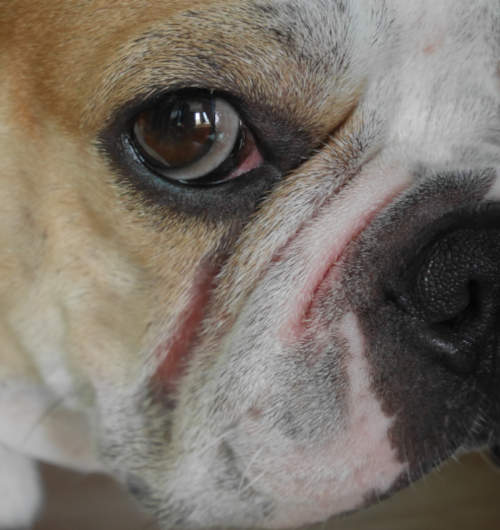
Demodectic mange: mange can cause hair loss, redness, and pustules on a dog’s face and chin, as shown on the picture below.
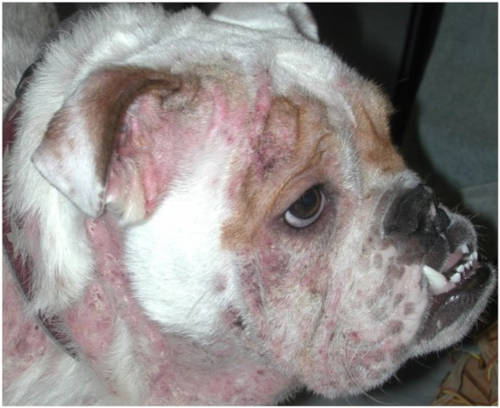
Picture: © Ian Brett Spiegel VMD, MHS, DACVD
Fungal infections like ringworm.
These conditions may not have the same acne appearance in later stages but might appear as small pustules, redness, or hair loss in the beginning.
How to prevent acne
Dog acne may be a chronic condition with lifelong flare-ups, but determining the cause of acne can help prevent or manage the condition in the future. You can take a few steps to manage your dog’s overall health and reduce the risk of dog acne.
Healthy diet: Find a diet that suits your dog’s lifestyle and needs. Commercially prepared diets include ingredients like fatty acids and vitamins that promote healthy skin.
Manage allergies: Allergies can undermine the skin’s natural defense system, leaving your dog vulnerable to infection and other issues. By treating and controlling allergies, the skin is healthier overall.
Hygiene: If your dog has deep wrinkles or short bristle-like hair on his face, you may need to do some proactive grooming and skincare. Keep a gentle wipe or cleaner on hand to clean those deep crevices around the face.
- Groom & Refresh Daily – Hypoallergenic dog wipes gently remove dirt, dander, and odors from paws, body, and butt between baths—keeping pets clean and fresh with zero fuss.
Frequently asked questions
Which dogs are more likely to be impacted?
Short-haired breeds or those with wrinkly and creviced skin around the muzzle are more at risk for developing some chin acne. These breeds include boxers, pugs, Rottweilers, English bulldogs, Dobermans, and German short-haired pointers.
Many of us associate acne with our younger teenage years and fluctuating hormones, but this isn’t exactly true for dogs. While acne typically occurs in dogs under two years old, it is generally not caused by hormonal imbalances. There is more likely a genetic component, meaning some breeds may be more at risk than others. Dogs with shorter bristled hair, such as short-haired pointers, tend to have more acne than longer-haired breeds. Dogs with deep skin wrinkles and crevices also develop acne around the lips and mouth; the deep crevices retain moisture and bacteria.
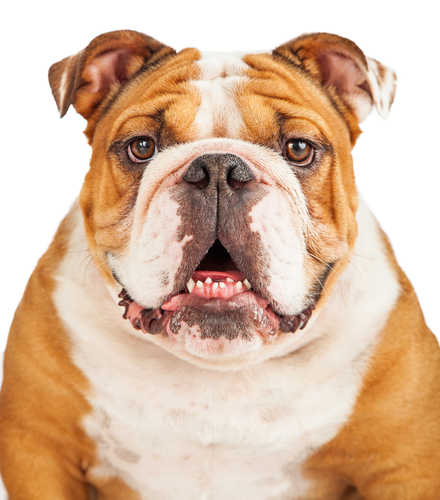
Acne in dogs also results from trauma to the hair follicles, so scratching and rubbing from injury or allergies can also cause it. Food or environmental allergies can common culprits. The skin is more susceptible to infections in dogs with chronic allergies due to the constant scratching.
Can dogs get pimples?
Yes! Our canine companions can get pimples just like we do! They are often small red or white swellings on the chin, lips, and muzzle. The surrounding skin may be inflamed as well. Interestingly, canine acne is typically NOT caused by hormones, though. More often, it is genetic, meaning some dogs (and some dog breeds) may be more at risk than others.
Will dog acne go away on its own?
Mild cases of acne may go away on their own. Minor changes to the dog’s hygiene may help too. Changing bowls from plastic to metal or ceramic can help. Keep the area clean and dry. Dogs that have skin wrinkles or folds may need extra doggy spa pampering.
Can food allergies cause dog acne?
Allergies often cause intense itching and scratching all over the body, weakening the outer layers of the skin and making them more susceptible to infection, trauma, and inflammation. Dogs with food allergies may develop chin or muzzle acne, especially if they are itching or rubbing their chins on the ground. In these cases, managing the allergy is key to keeping your dog’s skin healthy and preventing acne.
Is it contagious?
Typically, dog acne is not contagious. The risk of spreading it to another pet or human is low, even with a bacterial infection. It is important to ensure it is acne – not ringworm – which is highly contagious.
Is it the same as acne in humans?
Yes and no. Dog acne is similar to human acne in that it is a swelling that often contains sebum (oils from the sebaceous glands on the skin), dead skin cells, and sometimes bacteria and pus. It is different than human acne because it usually isn’t caused by hormonal changes in dogs.
How do hair follicles get clogged up?
In the image below, the picture on the left shows the skin layers (epidermis, dermis, and subcutaneous layer) with blood supply, hair follicle, and small sebaceous gland to the left of the hair. The picture on the right shows a clogged pore with pus and inflammation:
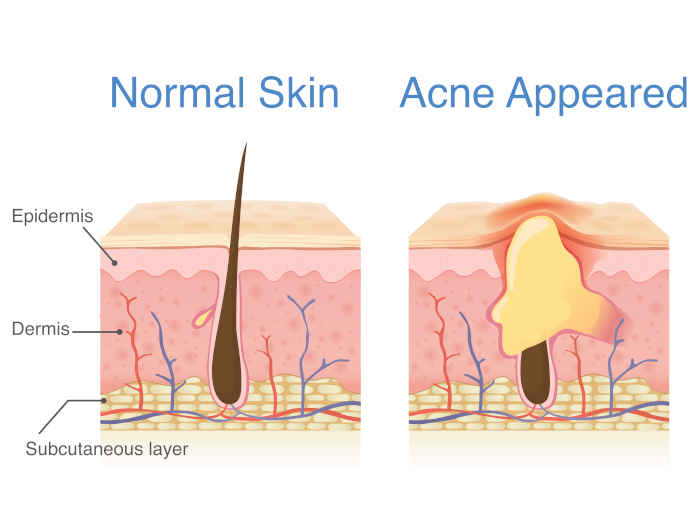
Disclaimer: This website's content is not a substitute for veterinary care. Always consult with your veterinarian for healthcare decisions. Read More.




Be the first to comment